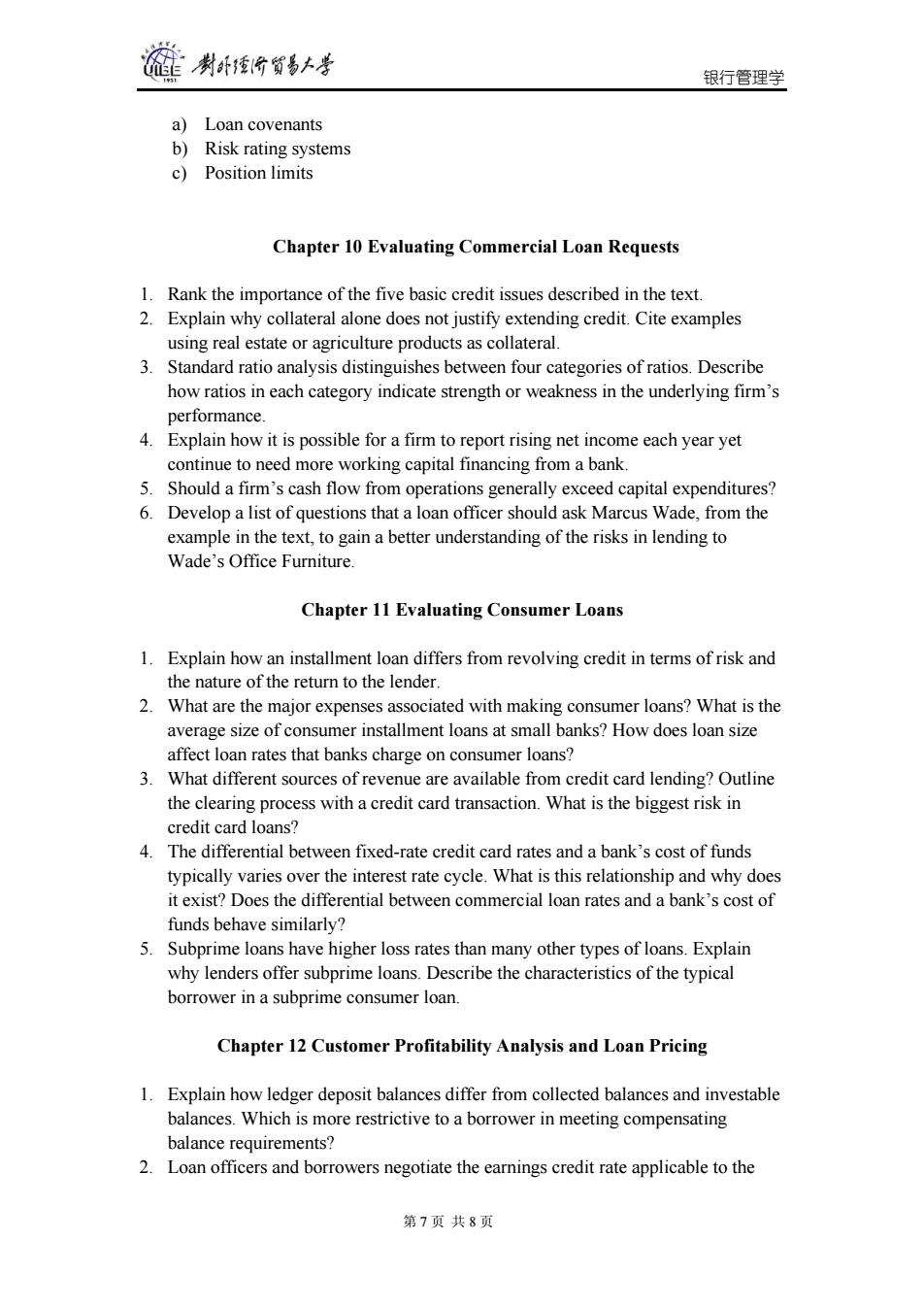正在加载图片...

”制卧台贸易上兰 银行管理学 a)Loan covenants b)Risk rating systems c)Position limits Chapter 10 Evaluating Commercial Loan Requests 1.Rank the importance of the five basic credit issues described in the text. 2.Explain why collateral alone does not justify extending credit.Cite examples using real estate or agriculture products as collateral. 3.Standard ratio analysis distinguishes between four categories of ratios.Describe how ratios in each category indicate strength or weakness in the underlying firm's performance. 4.Explain how it is possible for a firm to report rising net income each year yet continue to need more working capital financing from a bank. 5.Should a firm's cash flow from operations generally exceed capital expenditures? 6.Develop a list of questions that a loan officer should ask Marcus Wade,from the example in the text,to gain a better understanding of the risks in lending to Wade's Office Furniture. Chapter 11 Evaluating Consumer Loans 1.Explain how an installment loan differs from revolving credit in terms of risk and the nature of the return to the lender. 2.What are the major expenses associated with making consumer loans?What is the average size of consumer installment loans at small banks?How does loan size affect loan rates that banks charge on consumer loans? 3.What different sources of revenue are available from credit card lending?Outline the clearing process with a credit card transaction.What is the biggest risk in credit card loans? 4.The differential between fixed-rate credit card rates and a bank's cost of funds typically varies over the interest rate cycle.What is this relationship and why does it exist?Does the differential between commercial loan rates and a bank's cost of funds behave similarly? 5.Subprime loans have higher loss rates than many other types of loans.Explain why lenders offer subprime loans.Describe the characteristics of the typical borrower in a subprime consumer loan. Chapter 12 Customer Profitability Analysis and Loan Pricing 1.Explain how ledger deposit balances differ from collected balances and investable balances.Which is more restrictive to a borrower in meeting compensating balance requirements? 2.Loan officers and borrowers negotiate the earnings credit rate applicable to the 第7页共8页银行管理学 第 7 页 共 8 页 a) Loan covenants b) Risk rating systems c) Position limits SUMMARY Chapter 10 Evaluating Commercial Loan Requests 1. Rank the importance of the five basic credit issues described in the text. 2. Explain why collateral alone does not justify extending credit. Cite examples using real estate or agriculture products as collateral. 3. Standard ratio analysis distinguishes between four categories of ratios. Describe how ratios in each category indicate strength or weakness in the underlying firm’s performance. 4. Explain how it is possible for a firm to report rising net income each year yet continue to need more working capital financing from a bank. 5. Should a firm’s cash flow from operations generally exceed capital expenditures? 6. Develop a list of questions that a loan officer should ask Marcus Wade, from the example in the text, to gain a better understanding of the risks in lending to Wade’s Office Furniture. Chapter 11 Evaluating Consumer Loans 1. Explain how an installment loan differs from revolving credit in terms of risk and the nature of the return to the lender. 2. What are the major expenses associated with making consumer loans? What is the average size of consumer installment loans at small banks? How does loan size affect loan rates that banks charge on consumer loans? 3. What different sources of revenue are available from credit card lending? Outline the clearing process with a credit card transaction. What is the biggest risk in credit card loans? 4. The differential between fixed-rate credit card rates and a bank’s cost of funds typically varies over the interest rate cycle. What is this relationship and why does it exist? Does the differential between commercial loan rates and a bank’s cost of funds behave similarly? 5. Subprime loans have higher loss rates than many other types of loans. Explain why lenders offer subprime loans. Describe the characteristics of the typical borrower in a subprime consumer loan. Chapter 12 Customer Profitability Analysis and Loan Pricing 1. Explain how ledger deposit balances differ from collected balances and investable balances. Which is more restrictive to a borrower in meeting compensating balance requirements? 2. Loan officers and borrowers negotiate the earnings credit rate applicable to the